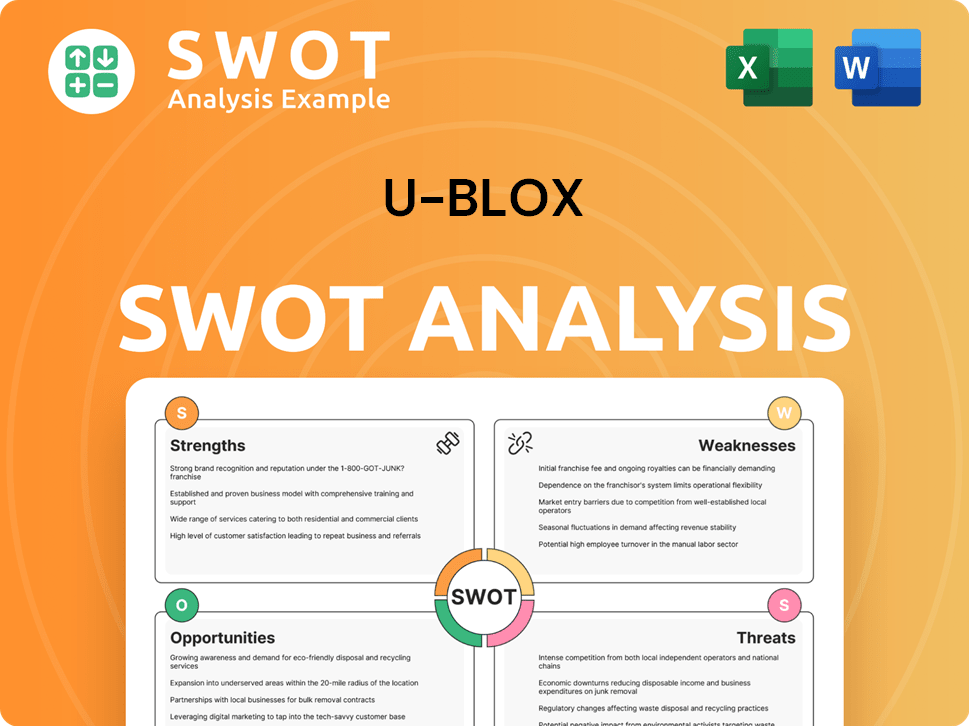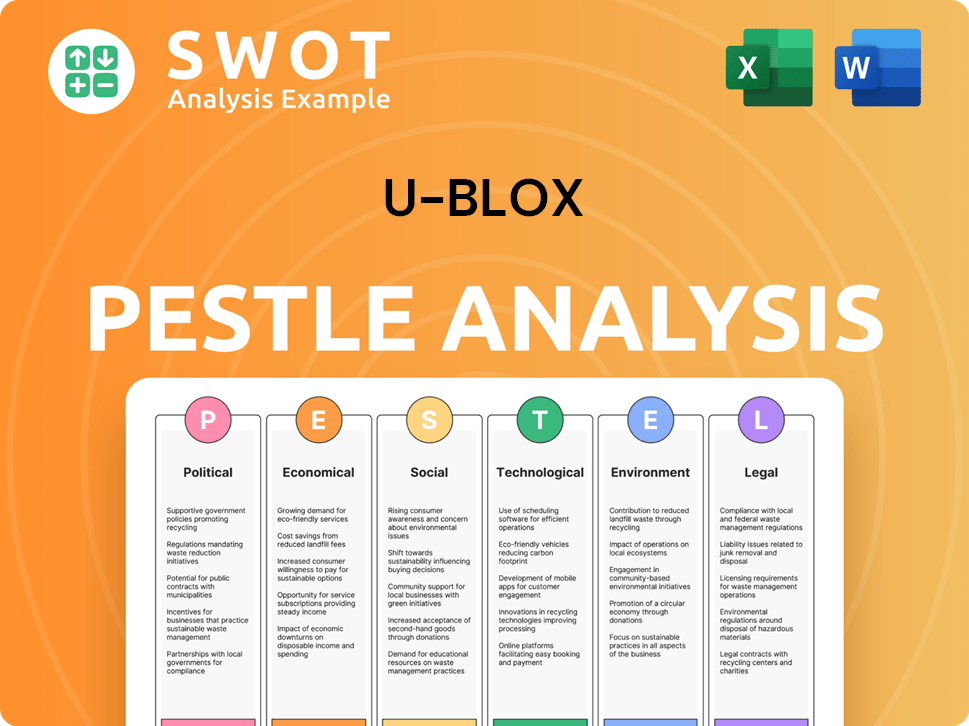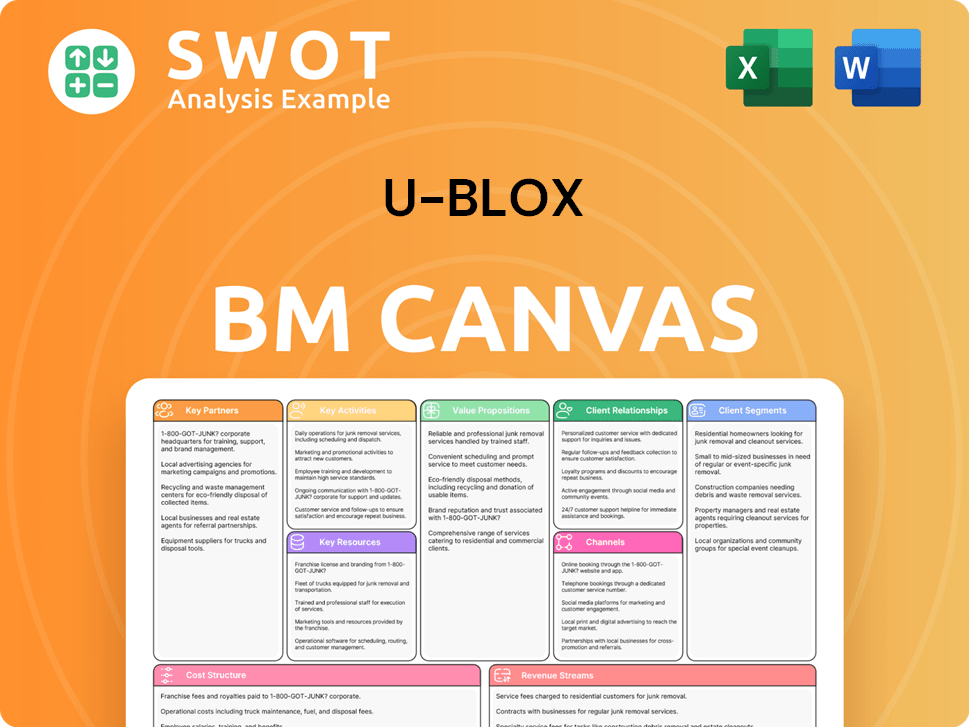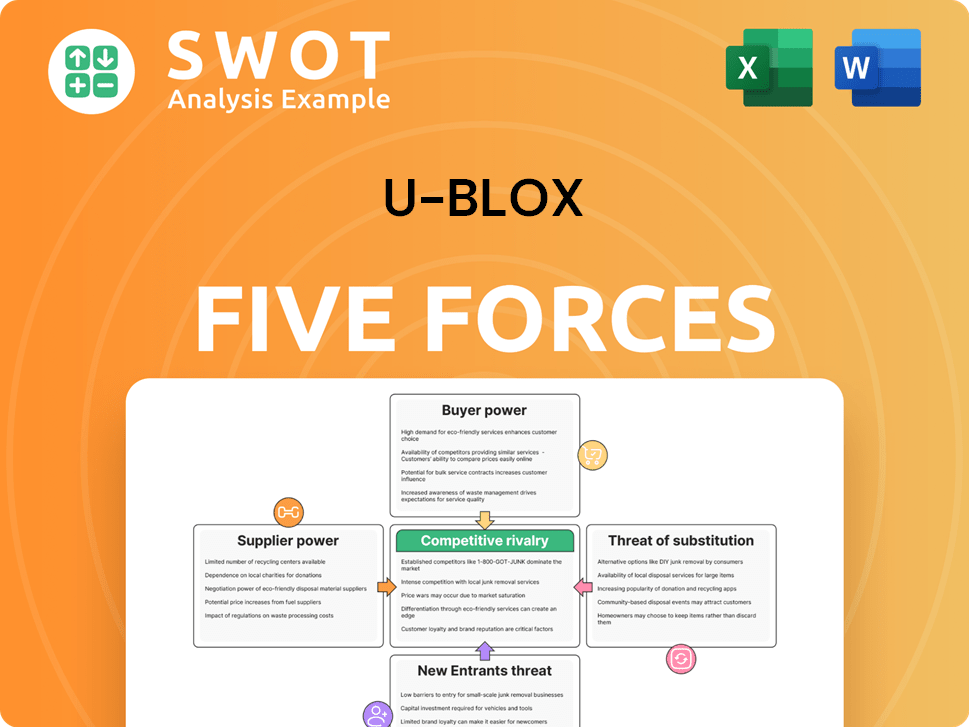u-blox Bundle
How Did a Swiss Technology Company Become a Global Leader?
Born from the Swiss Federal Institute of Technology in Zurich in 1997, u-blox embarked on a journey to revolutionize positioning and wireless communication. Initially focused on pioneering high-quality satellite signal receiver modules, this u-blox SWOT Analysis reveals how the company has grown from its academic roots. Today, u-blox stands as a global provider, its history a testament to innovation and adaptability.

This brief history of u-blox highlights its evolution from a startup to a key player in the tech industry. The u-blox company has consistently adapted to market demands, expanding its u-blox products and services to meet the needs of the automotive, industrial, and consumer markets. Understanding the u-blox timeline provides valuable context for investors and industry analysts alike, offering insights into its strategic growth and market positioning.
What is the u-blox Founding Story?
The journey of u-blox, a prominent Swiss technology company, began in 1997. It emerged as a spin-off from the Swiss Federal Institute of Technology in Zurich (ETH).
Headquartered in Thalwil, Switzerland, the company was founded by individuals including Ray Bogans and Andreas Thiel. Their venture was built upon post-graduate research and an invention developed at ETH Zurich.
The initial focus of u-blox was developing the world's first Global Positioning System (GPS) module. This module quickly became an industry standard for GPS receivers in industrial applications.
The founders of u-blox were committed to independence, choosing to develop their own positioning chip rather than relying on external semiconductor providers.
- The first GPS chipset was released in 2002.
- u-blox has raised a total of $12.1 million over three funding rounds.
- The first recorded funding round was on August 31, 2001.
- The early years were marked by the challenge of commercializing cutting-edge academic research.
u-blox SWOT Analysis
- Complete SWOT Breakdown
- Fully Customizable
- Editable in Excel & Word
- Professional Formatting
- Investor-Ready Format

What Drove the Early Growth of u-blox?
The early years of the u-blox company were marked by substantial growth, primarily fueled by its innovative GPS products. This Swiss technology company quickly established itself in the market, expanding its reach and product offerings. Key milestones during this period included the development of its own GPS receiver chip and strategic acquisitions to broaden its technology portfolio.
In 1998, u-blox introduced its initial commercial GPS product, which was deployed in Switzerland's heavy vehicle road pricing system (LSVA). By 2000, the company's GPS receiver module was integrated into the first GPS-enabled mobile phone, a significant step into the consumer market. This early integration highlighted u-blox's forward-thinking approach to market trends.
The company expanded its global footprint in 2001 by opening offices in the USA and Asia. A pivotal moment occurred in 2002 when u-blox developed its own GPS receiver chip, and Thomas Seiler assumed the CEO position, a role he held until December 2022. This leadership transition and technological advancement were crucial for the company's trajectory.
By 2004, u-blox had delivered its 1 millionth GPS receiver, demonstrating strong market penetration. The company's Initial Public Offering (IPO) on the Swiss stock exchange in 2007, a decade after its founding, reflected its robust growth and valuation. This IPO provided further resources for expansion and innovation.
In 2008, u-blox launched AMY, the world's smallest GPS module, and had delivered 10 million GPS receivers. The company diversified into wireless markets through acquisitions, including NeonSeven and Geotate in 2009, leading to the introduction of wireless modules based on GSM (2G) and UMTS (3G) standards in 2010. Further acquisitions, such as Fusion Wireless in 2011, expanded their CDMA module offerings for the North American market. For more insights into the u-blox's target audience, consider reading about the Target Market of u-blox.
u-blox PESTLE Analysis
- Covers All 6 PESTLE Categories
- No Research Needed – Save Hours of Work
- Built by Experts, Trusted by Consultants
- Instant Download, Ready to Use
- 100% Editable, Fully Customizable

What are the key Milestones in u-blox history?
The u-blox company has achieved several significant milestones, marking its evolution as a Swiss technology company in the location and wireless communication sectors.
| Year | Milestone |
|---|---|
| 2016 | Launched the world's first cellular Narrowband IoT (NB-IoT) module, SARA-N2, and the LARA-R3121 cellular module with proprietary UBX-R3 LTE modem technology and integrated GNSS. |
| 2016 | Celebrated its 20th anniversary. |
| 2018 | Launched the u-blox F9 high-precision GNSS platform, capable of delivering centimeter-level accuracy. |
| 2020 | Partnered with Focal Point Positioning to integrate Supercorrelation technology into next-generation GNSS chips. |
| 2021 | Acquired Sapcorda Services GmbH and Naventik GmbH. |
| 2023 | Introduced its first multi-mode Cellular and Satellite module and by October, sold its 25 millionth LTE-M cellular module. |
| 2024 | Launched the next-generation X20 GNSS platform and entered a strategic partnership with Topcon Positioning Systems. |
| 2025 | Launched the ZED-X20P, an all-band GNSS module. |
| 2025 | Expanded its NORA-B2 Bluetooth Low Energy modules series, and introduced RUBY-W2, its first automotive-grade Wi-Fi 7 module. |
u-blox has consistently pushed the boundaries of innovation in its field. The company's focus on high-precision GNSS technology and advanced cellular modules has positioned it as a leader in location and wireless communication solutions.
The u-blox F9 platform, launched in 2018, provided centimeter-level accuracy. The ZED-X20P module, launched in early 2025, aims to deliver global, centimeter-level location precision at a reduced cost.
The SARA-N2 NB-IoT module and the SARA-R5 series showcase u-blox's expertise in cellular technologies. The company reached a milestone of selling its 25 millionth LTE-M cellular module by October 2023.
Collaborations with companies like Focal Point Positioning and Topcon Positioning Systems have enhanced u-blox's technological capabilities. These partnerships aim to improve positioning accuracy and expand service offerings.
The acquisitions of Sapcorda Services GmbH and Naventik GmbH have broadened u-blox's portfolio. These acquisitions have allowed u-blox to offer high-precision GNSS services and safe positioning solutions for autonomous driving.
The introduction of the first multi-mode Cellular and Satellite module in 2023 demonstrates the company's ability to adapt to market demands. This module provides enhanced connectivity options for various applications.
The introduction of the RUBY-W2, its first automotive-grade Wi-Fi 7 module, in January 2025, shows u-blox's commitment to providing the latest wireless technology. This module is designed to meet the demanding requirements of the automotive industry.
Despite these achievements, u-blox has faced significant challenges in recent years. The company experienced a challenging year in 2024, with revenue totaling CHF 262.9 million, a 54% decline compared to 2023.
The industrial and automotive sectors experienced market softness, impacting revenue. The cellular division faced persistent losses due to intense price competition and slow adoption of emerging cellular technologies outside China.
In January 2025, u-blox announced a strategic decision to phase out its cellular IoT business. This decision aims to increase focus on more profitable segments, such as Locate (GNSS) and Short-Range businesses.
The phase-out of the cellular IoT business is expected to eliminate at least CHF 30 million in annual EBIT losses. A one-time negative EBIT impact of approximately CHF 65 million was incurred in Q1 2025, with about 40% of this being cash-related expenses.
u-blox implemented a cost optimization program in 2024, exceeding its target by achieving CHF 25 million in savings. The company generated positive free cash flow of CHF 10.1 million in 2024, despite the challenging market conditions.
A non-cash negative EBIT impact of CHF 31 million in Q4 2024 from intangible assets impairment further reflects the financial challenges. This highlights the need for strategic adjustments to improve profitability.
The strategic shift towards the Locate (GNSS) and Short-Range businesses aims to capitalize on more profitable areas. This focus is designed to drive future growth and improve financial performance.
u-blox Business Model Canvas
- Complete 9-Block Business Model Canvas
- Effortlessly Communicate Your Business Strategy
- Investor-Ready BMC Format
- 100% Editable and Customizable
- Clear and Structured Layout

What is the Timeline of Key Events for u-blox?
The u-blox history is marked by significant innovation and strategic expansion in the fields of positioning and wireless communication. Founded as a spin-off from the Swiss Federal Institute of Technology in Zurich (ETH) in 1997, the company quickly established itself as a pioneer in GPS technology, developing the first commercial GPS product for heavy vehicle road pricing in Switzerland in 1998. Over the years, u-blox has expanded its product portfolio, entering the wireless market through acquisitions and internal developments, including cellular modules and short-range communication technologies. The company has demonstrated continuous growth, marked by an initial public offering (IPO) in 2007 and strategic acquisitions to broaden its technological capabilities. Recent developments include a strategic shift towards its Locate and Short-Range businesses.
| Year | Key Event |
|---|---|
| 1997 | Founded as a spin-off from the Swiss Federal Institute of Technology in Zurich (ETH). |
| 1998 | Developed the first commercial GPS product for the heavy vehicle road pricing system in Switzerland. |
| 2000 | Provided the GPS receiver module for the first GPS-enabled mobile phone. |
| 2002 | Developed its own GPS receiver chip; Thomas Seiler became CEO. |
| 2007 | Successfully completed IPO on the Swiss stock exchange. |
| 2008 | Launched AMY, the world's smallest GPS module; delivered 10 millionth GPS receiver. |
| 2009 | Entered the wireless market through acquisitions (NeonSeven, Geotate); introduced GSM (2G) wireless modules. |
| 2016 | Launched the world's first cellular NB-IoT module (SARA-N2) and SARA-R3121 with proprietary LTE modem technology. |
| 2018 | Launched the u-blox F9 high-precision GNSS platform. |
| 2020 | Partnered with Focal Point Positioning for Supercorrelation technology integration. |
| 2021 | Acquired Sapcorda Services GmbH and Naventik GmbH. |
| 2023 | Introduced its first multi-mode Cellular and Satellite module. |
| 2024 | Faced revenue decline (CHF 262.9 million) and adjusted EBIT losses (CHF -59.6 million) due to overstocking and market softness; launched X20 GNSS platform and partnered with Topcon Positioning Systems; implemented cost optimization program, saving CHF 25 million. |
| January 2025 | Announced strategic decision to phase out Cellular business to focus on Locate and Short-Range businesses. |
| Q1 2025 | Reported revenue of CHF 70.4 million, a 26% year-over-year increase; Locate revenue grew 43% year-over-year to CHF 51.9 million; Cash EBIT (adjusted) reached CHF -3.6 million. |
u-blox is concentrating on its Locate (GNSS) and Short-Range communication technologies. This strategic shift aims to capitalize on the growing demand in automated driving, precision agriculture, and mobile robotics, with double-digit revenue growth expected in both segments throughout 2025, excluding the Cellular business.
The company is targeting a positive cash EBIT in Q2 2025, excluding the cellular segment, and anticipates the Short-range segment to break even in the second half of 2025. u-blox aims for a revenue target of CHF 350 million and a cash EBIT margin of over 25% for its Locate business.
u-blox plans a substantial reduction in R&D capitalization, with low single-digit capitalization expected in 2025. The company's focus on high-growth markets like autonomous vehicles and industrial IoT aligns with its core strengths in precise positioning and reliable connectivity.
In Q1 2025, u-blox reported a 26% year-over-year revenue increase, with Locate revenue growing by 43%. The company is adjusting its business model to align with market demands and achieve profitability, aiming for sustainable growth in its core segments. The strategic decision to phase out the Cellular business is a key part of this transformation.
u-blox Porter's Five Forces Analysis
- Covers All 5 Competitive Forces in Detail
- Structured for Consultants, Students, and Founders
- 100% Editable in Microsoft Word & Excel
- Instant Digital Download – Use Immediately
- Compatible with Mac & PC – Fully Unlocked

Related Blogs
- What is Competitive Landscape of u-blox Company?
- What is Growth Strategy and Future Prospects of u-blox Company?
- How Does u-blox Company Work?
- What is Sales and Marketing Strategy of u-blox Company?
- What is Brief History of u-blox Company?
- Who Owns u-blox Company?
- What is Customer Demographics and Target Market of u-blox Company?
Disclaimer
All information, articles, and product details provided on this website are for general informational and educational purposes only. We do not claim any ownership over, nor do we intend to infringe upon, any trademarks, copyrights, logos, brand names, or other intellectual property mentioned or depicted on this site. Such intellectual property remains the property of its respective owners, and any references here are made solely for identification or informational purposes, without implying any affiliation, endorsement, or partnership.
We make no representations or warranties, express or implied, regarding the accuracy, completeness, or suitability of any content or products presented. Nothing on this website should be construed as legal, tax, investment, financial, medical, or other professional advice. In addition, no part of this site—including articles or product references—constitutes a solicitation, recommendation, endorsement, advertisement, or offer to buy or sell any securities, franchises, or other financial instruments, particularly in jurisdictions where such activity would be unlawful.
All content is of a general nature and may not address the specific circumstances of any individual or entity. It is not a substitute for professional advice or services. Any actions you take based on the information provided here are strictly at your own risk. You accept full responsibility for any decisions or outcomes arising from your use of this website and agree to release us from any liability in connection with your use of, or reliance upon, the content or products found herein.